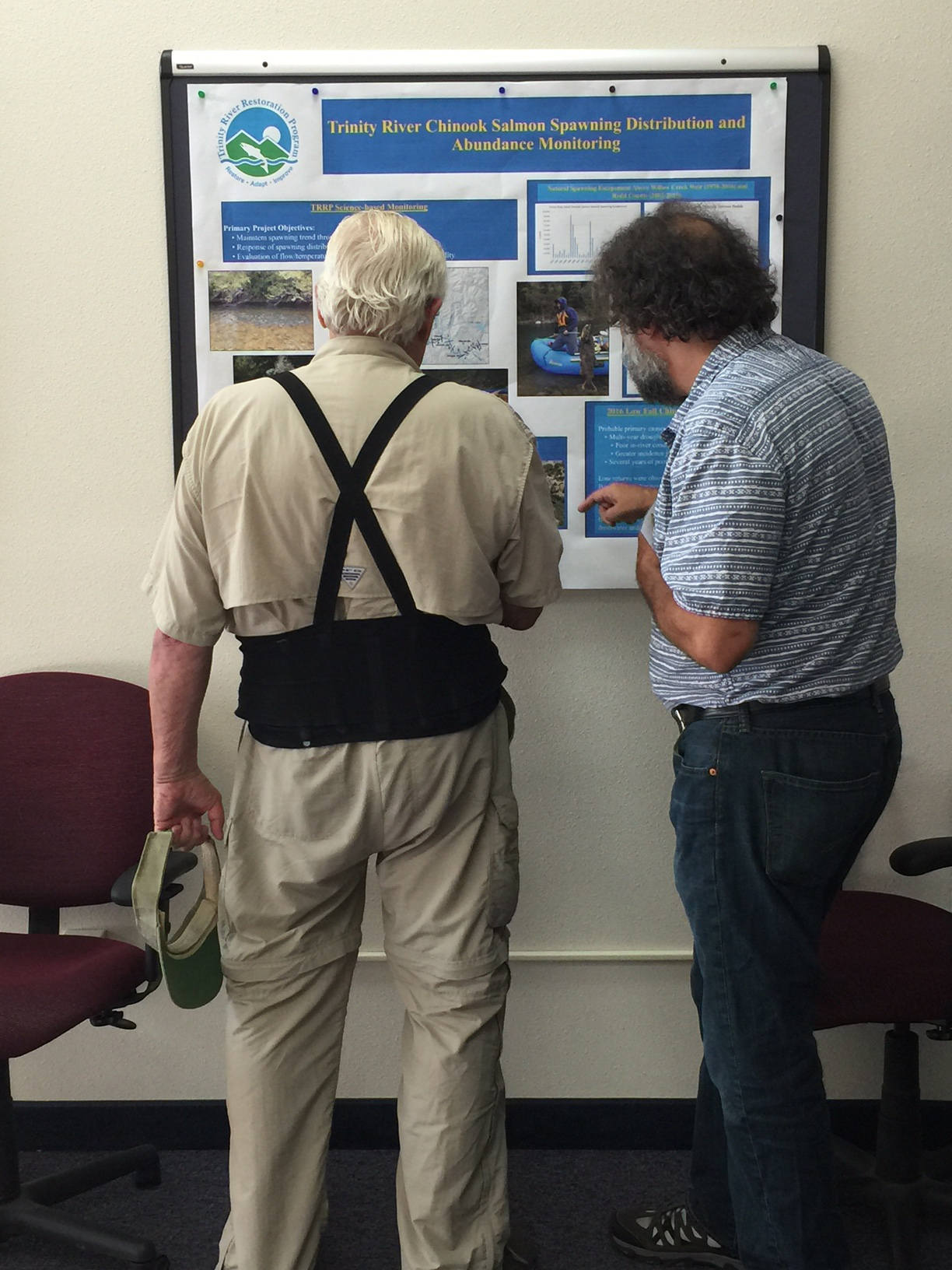As with most management of natural resources, many stakeholders and other members of the public are both interested in how the Trinity River is managed, and have thoughts on how management could be improved. TRRP welcomes questions and input from our numerous stakeholders and the general public. Here are some suggestions on how you can productively engage with our activities.

A TRRP fisheries biologist from the U.S. Fish and Wildlife Service (Arcata office) discusses salmon abundance with a member of the public at an Open House event.
Be informed so that you can provide effective suggestions
Become knowledgeable about the TRRP’s goals, methods of restoration, and limits to scope (e.g. we have no authority over what happens to salmon in the ocean). We are a complex collaboration of agencies and the more you know, the more effectively you can engage with us. You are on our website, so you are off to a great start! Here are some specific tips:
- Goal Statement on Our Home Page – An abbreviated goal statement can be found near the top with a “click to expand” for the full version. Our home page also has lots of other current information.
- Agencies that form the TRRP – we are a broad collaborative.
- Restoration Pages – The reasons why the river needs restoration are briefly described on our main restoration page, which has many links to further details. Alternatively, you can explore the menu system.
- TRRP Annual Reports – These provide a strong overview of what the program is doing across numerous topics including restoration actions and science-based adaptive management.
- Foundational Documents – This is a list of documents that lay the foundations for what we do. Among these…
- The Record of Decision, or ROD, (2000) is what officially formed the TRRP based on…
- The Flow Evaluation Final Report (1999) and the EIS/EIR (2000).
- Headwater’s Report – The many documents that followed since 2000 provide strategies to follow within the ROD or reviews on improving program. The Headwater’s Report is the most recent review and drew heavily on interviews with staff across the program for an introspective view on how we might change for the better; an ongoing “refinements” process is working with Headwater’s to implement changes.
- DataPort – Take some time to browse what we have publicly available, including…
- The library of documents and data relevant to the Trinity River,
- Online mapping for river restoration,
- The Restoration Action Database, and
- “RiverView”, a way to virtually float down the river.
- Calendar – Get familiar with the TRRP calendar, (there is also an abbreviated list of upcoming events on our home page). We use Google’s calendar system so you can merge it into your own calendar app.
Participate!
- Our central office in Weaverville is federally-based, and has been mostly closed in recent times due to COVID-19. We look forward to opening the door again so you can come in with questions and suggestions. In the meantime, our general office contacts are 530-623-1800 and info@trrp.net.
- Our quarterly TMC meetings are open to the public and have time specified on the agenda at the beginning and end of each day for public comment. This is a fantastic way to interact with program leadership and get your contributions recorded in the minutes! These meetings have also been impacted by COVID-19, so for the moment, please anticipate that you will participate through your computer. Agendas with electronic meeting links are posted on the TMC page.
- Public Meetings and Events that we hold in-person during “normal” times have various purposes. We enjoy having many people participate in these! It may help to understand the intent of a meeting…
- A scoping meeting is to seek ideas on what needs to be considered for a particular management action.
- Some informational meetings are to present restoration action that has already been evaluated by numerous program scientists and water managers, so the meeting is to answer questions on what the action will be and why.
- Open-house events, fair booths, and public floats are opportunities for broad conversations across many topics.
- Public comment periods are actually not required for most of our restoration activities, yet we frequently do open Environmental Assessments (EAs) for public comment. These are announced on our website’s home page and in the Trinity Journal. Comments are most effective if they address specifics (see the BLM Commenting Guide). Comments can make a difference: a good example is our Bucktail project where a proposed relocation of the boat ramp was unpopular with the local community and resulted in a significant reworking of the site design.
